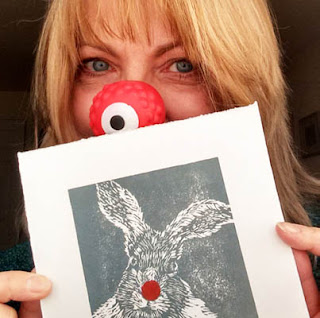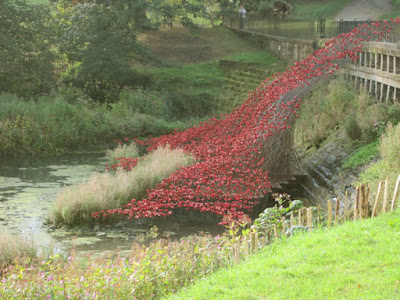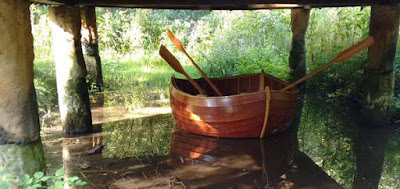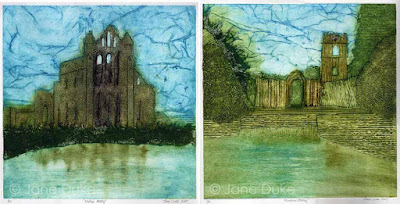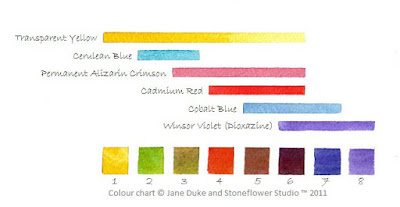For a long time the finished pear in this demo was my logo, and in fact it's still hanging around on business cards, labels and signage. (Well you don't expect someone from Yorkshire to chuck out perfectly good stationery do you?) A step-by-step demonstration showing how I painted it was on my website for a couple of years but this took on a life of its own and spread across social media, forums and Pinterest boards, often without attribution, and copies started popping up with other artists' names on. Eventually the day came that someone saw my signage at a show and said "Oh I know where that pear comes from; you got it off that demo on Facebook, didn't you?". Enough was enough.
I took the demo down from my website and instead made it available as a free pdf which people could request by email for their own personal use. All continued happily until someone casually mentioned that she ran art workshops and she was going to print off lots of copies and use them for classes. Errm... excuse me but no.... write your own course material and handouts LIKE I DO.
At that point I'm afraid I took my ball home and withdrew the demo completely for a while, but being a kindly and generous soul I'm now sharing it with you here. I hope you find it useful - if you try it then please do leave a comment below and let me know how you get on.
*******************
The demonstration shows how to develop colours using wet on dry glazing - this technique exploits the translucent qualities of watercolour so that underlying colours affect and alter the colours painted over them. It is
vital for this method that each layer is allowed to dry completely before adding the next. (All paints used are
Winsor & Newton Artist quality).
The painting begins with a layer of Transparent Yellow applied with a size 8 round brush. The brush should always make first contact with the paper where you want the colour to be strongest; do not simply start at the edge of a shape and 'colour in'. Here the paint goes on first at the bulge of the pear where it is closest to the viewer; this will help create a sense of form and depth.
Before the paint dries, a clean damp brush is used to soften the edges to increase the sense that sides of the pear are receding. The edges of the reserved highlights are also softened in the same way.
The first layer is allowed to dry thoroughly. Before moving on, the pencil outline of the pear is carefully erased before further paint and water can seal it in. A layer of Quinacridone Gold is added to the warmest areas of the pear skin.
In the next layer we can begin to see the effects of glazing with transparent colours. A wash of Permanent Sap Green is applied to all but the yellowest areas. On its own, Sap Green would be too cold and harsh but layered over yellow it softens and mellows. Again the colour is strongest in the centre, softening towards the edges. The green is carried a little way up the stalk too to aid continuity later.
Once the painting is dry again, Cerulean Blue is added to areas in shadow. The effect over the previous yellow and green is to produce a dark green. Cerulean Blue is a granulating colour so as it dries it will help to add texture to the painting.
The delicate dark green mottling on the skin is painted with a size 4 brush in Winsor Blue (Green Shade). Tiny dots are added first and then immediately softened and blended with clean water. It is important that the dots are not allowed to dry before they are softened so you need to work on small areas at a time, moving steadily across the painting.
The same technique is then used to add the red mottling. This is predominantly Cadmium Red which is a strong opaque colour and needs to be used with care. Kept thin and light at the edges it blends into the earlier colours, but used more strongly in the centre, its opacity means it can stay bright zingy red without being compromised by the underlying green. In areas which need to be less bright but still strong, a little Permanent Alizarin Crimson is used.
The stalk is painted with a size 6 round brush in Burnt Umber with a touch of Winsor Blue (Green Shade) dropped in half way along. The colour is blended into the flesh of the pear to make sure the stalk grows out from the fruit and is not 'stuck on'. The very end of the stalk is deliberately blurred with clean water so that the eye is not drawn to a hard edge and distracted from the pear.
The shadow shape is first painted with clean water. Winsor Blue (G) is then added in the strongest area on the right and coaxed along to the rest of the shadow shape. While it is still wet some Sap Green, Transparent Yellow and a tiny amount of Cadmium Red are added to the shadow to indicate reflected colour from the pear. When the shadow is dry, the area immediately under the pear is strengthened with strong mix of Sap Green and Winsor Blue (G).
Pear with Shadow - © Jane Duke 2011







